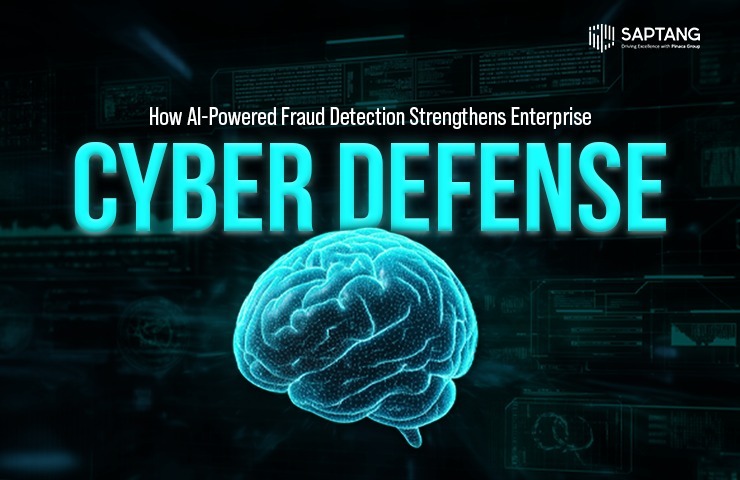
AI fraud detection is changing the way enterprises defend against phishing, spoofing, and insider threats. Unlike rule-based systems, AI learns behavior, detects unusual activity in real time, and scales across large teams. This means faster response, fewer false alarms, and stronger cyber defense without adding complexity.
In today’s digital world, fraud is no longer a small-scale problem. It has become more frequent, more organized, and more damaging, especially for large businesses. Attackers now use sophisticated methods to trick employees, steal credentials, and move money without setting off alarms.
Traditional security systems often struggle to keep up with them. That’s why many forward-thinking companies are turning to AI-powered fraud detection. This technology helps identify and stop threats faster and more accurately by learning how fraud behaves, not just what it looks like.
In this post, we’ll explore how AI fraud detection works, why it’s a game-changer for enterprise cyber defense, and what businesses should know before implementing it.
Most fraud detection tools rely on rules: “If this happens, then block it.” These rules work to a point, but attackers constantly change tactics to bypass them.
Let’s say a phishing email comes in a new format, or a payment is sent just under a flagged limit. A rules-based system might miss it because the pattern doesn’t match anything seen before.
This is where AI changes the game.
AI fraud detection uses machine learning to study behavior, learn patterns, and spot unusual activity that could signal a threat.
Instead of only looking for known bad behavior, AI watches how users normally act. If something seems like a login from a strange location, a file shared at an odd time, or a link sent from a rarely used email, it raises a flag.
The more the system learns, the better it gets at spotting what doesn’t belong.
It’s like having a digital security guard who learns your business and watches for anything out of place, quietly and constantly.
Let’s break down the keyways this technology strengthens enterprise-level cyber defense:
AI systems process large amounts of data in real time. This means threats like phishing links, spoofed logins, or fake invoices can be identified and stopped before harm is done.
A major challenge in cybersecurity is alert fatigue, when teams get too many warnings, many of which are false. AI helps reduce these by learning what’s normal and what’s not, so only real issues are flagged.
Whether your organization has 500 employees or 50,000, AI systems can monitor all of them without getting tired or missing details. This makes it ideal for large, distributed teams and hybrid workforces.
Attackers constantly change tactics. AI systems continue learning over time, so they can adjust and respond to new types of fraud that weren’t seen before.
When AI handles early detection and filtering, human analysts can focus on deeper investigation and response. This makes security operations more effective and less overwhelming.
Real-World Example: A Simple Enterprise Scenario
Imagine an employee in a finance team receiving an email from what looks like their manager, asking to urgently approve a large wire transfer.
Email is crafted carefully. It doesn’t match known phishing templates. But the AI system notices something unusual:
The system automatically flags it, blocks the link, and alerts the SOC (Security Operations Center). Within minutes, the attempt is stopped; no money lost, no harm done.
That’s the power of intelligent fraud detection.
Implementing AI fraud detection is a big step, and it needs to be done thoughtfully. Here are key things to plan for:
The system learns from your data. Make sure it has access to relevant sources, email logs, user activity, login records, and more; so, it can learn properly.
AI tools need visibility into behavior but also must respect privacy rules. Choose a system that follows your country’s data protection laws (like India’s DPDP Act) and offers strong data controls.
Even good AI systems need tuning. Work with your vendor to adjust thresholds, review flagged events, and teach the system what matters to your business.
Fraud detection works best when connected to your other tools; SIEM, SOAR, email filters, and endpoint monitoring. Choose a solution that fits your broader security strategy.
At Saptang Labs, we understand that enterprise security needs more than just alerts; it needs clarity, context, and control.
That’s why our threat monitoring platform includes AI-driven fraud detection as a core feature. We:
Whether you’re a large financial firm, a growing enterprise, or a government-linked organization, we help you stay ahead of fraud without adding complexity.
Q1. How is it different from traditional fraud detection?
Traditional tools follow fixed rules. AI adapts, learns, and identifies new or subtle threats without needing constant rule updates.
Q2. Will it work with the systems we already use?
Yes. Many platforms integrate with SIEM, SOAR, email security, and cloud services to enhance what you already have.
Q3. Is it suitable for industries beyond banking?
Definitely. Any enterprise with sensitive data or large digital operations including healthcare, telecom, manufacturing, and government can benefit.
Q4. Can it reduce false positives?
Yes. Over time, the AI learns what’s normal and helps filter out noise, so your team focuses only on real issues.
Final Thoughts
Cyber threats are getting smarter. Your defenses need to be smarter too.
AI-powered fraud detection is not about replacing people; it’s about giving your team better tools to act faster, stay ahead, and stop threats before they cause damage.
If you’re thinking about how to scale your defense without burning out your team, now’s the time to explore intelligent fraud detection built for the way modern enterprises operate.